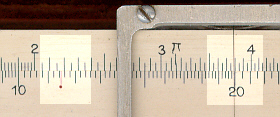1. This rule was designed for calculating the range for artillery. In the very military phrase "Rule Slide R.A." , the R.A. refers to the Royal Artillery.
2. Artillery binoculars had graticules (short lines) visible which enabled angles to be measured.
3. On the front the rule has gauge marks at 1.146 on all scales and at 8.70 on the A and B scales only. The 1146 mark is known as the Gunner's Mark.For small angles (< 20°) : tan q » sin q » q radians
The Gunner's mark makes use of this. On the rule set the angle in minutes on the B scale against the auxiliary base in feet on the A scale, the base in yards is read on the A scale against the Gunner's Mark on the B scale.

In effect the Gunner's mark (1146) is given by: 1/1146 = (p
x 3) / (180 x 60).
The other gauge mark 8.70 is, approximately, equal to the inverse of the Gunner's Mark (8.726) however, as the picture below shows, if this is the case the mark is not placed as accurately as it could be.
4. The reverse of the slide has trig scales to be used with the C and D scales. The trig scales are S (sine), T (tangent) and ST (sine and tangent for small angles.) Whilst there are small marks in cut out windows for the S and T scales there is not one for the ST scales. This face has and two additional gauge marks Although these marks are on the face of the slide with the trig scales, to be used on the C and D scales, they are intended to be used used with the A and B scales. When the Y gauge point is against the small mark in the window (detail - back right) the 100 on the B scale is against 91.4 on the A scale (detail - conversion to metres) showing the conversion factor from yards to metres. There is another gauge point marked F which acts similarly with a factor of 3 for conversion of yards to feet.
5. To examine the use of the Gunner's mark. Let us assume an angle of 20 minutes and an auxiliary base of 38 feet. Set the angle on the B scale against the auxiliary base of the A scale. The base (i.e. range) of 2080 yards is read on the A scale against the Gunner's mark on the B scale. (See picture example of Gunner's mark below).
6. To get the range in metres, set the Y gauge point to the mark in the window, move the cursor to the height in feet on the B scale, against the cursor set the angle and proceed as above. Effectively this method multiples the number of feet by the yards/metres conversion factor at the start of the calculation to give the required units at the end. It should be noted that I am working from the brief description on the back of the rule - the method of operation might be clearer if the full manual was available.
7. The rule has the words "M.C of S. No 241". My guess is that they stood for "Military College of Science". It appears to have been the successor of the Royal Military Academy which was founded at Woolwich in 1742. At some point its name changed to the Military College of Science. In 1941 to it moved to Bury in Lancashire, further from London, and in 1946 became the Royal Military College of Science and moved to Shrivenham in Wiltshire.
My thanks to John Oakhill for comments which enable me to make some corrections.

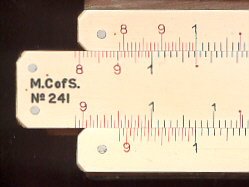
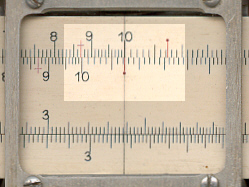
Slide reversed

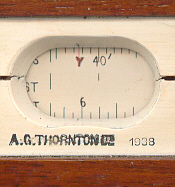
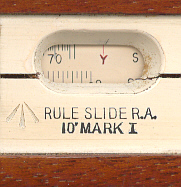
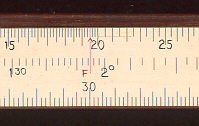
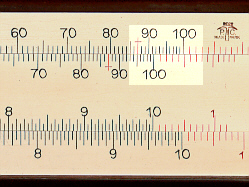
Example of Gunner's mark
